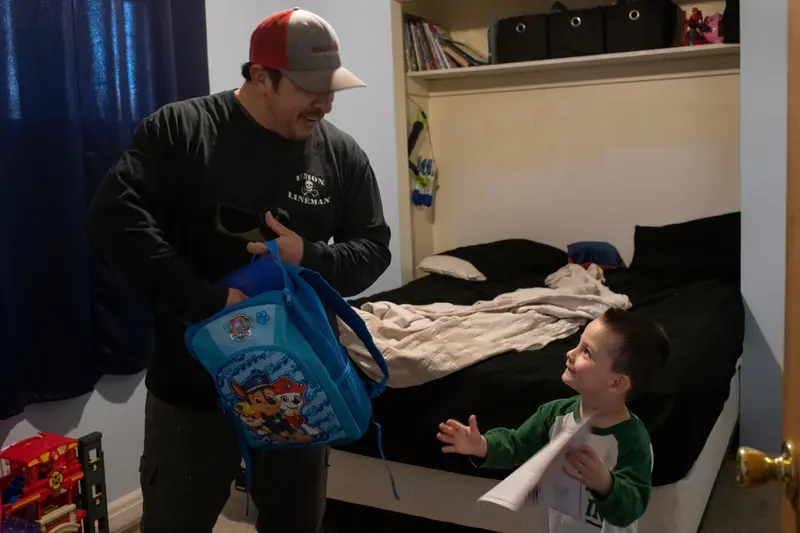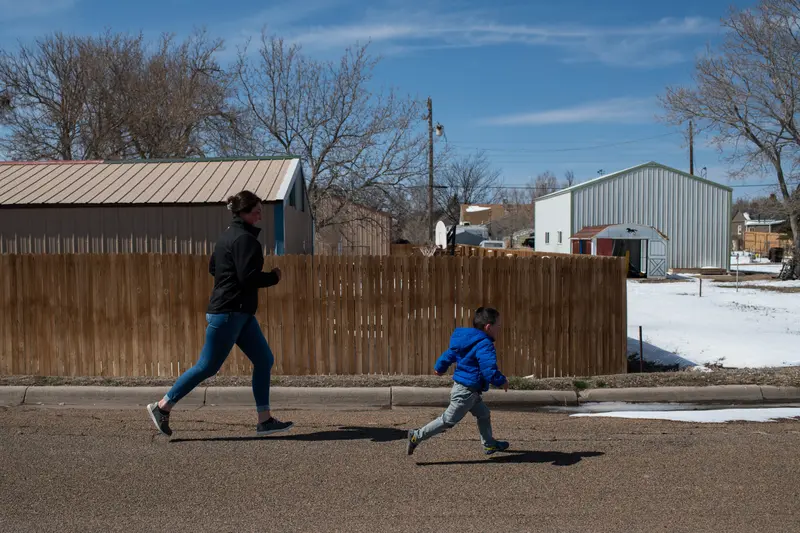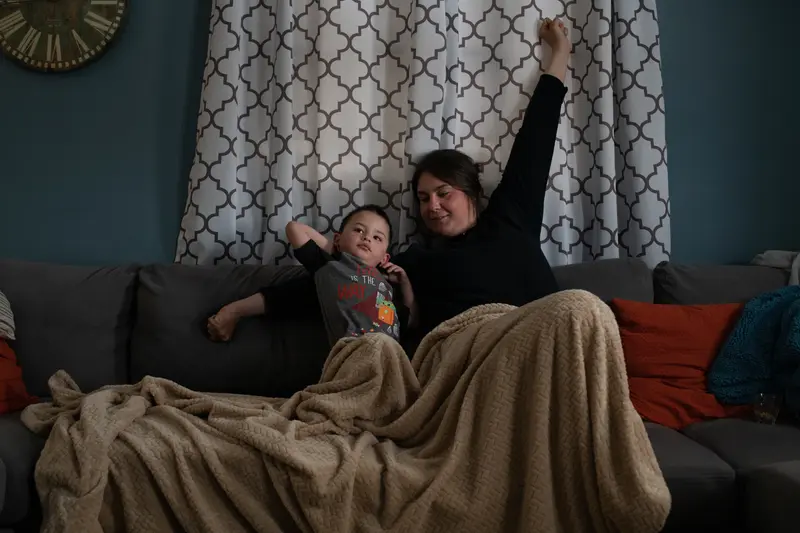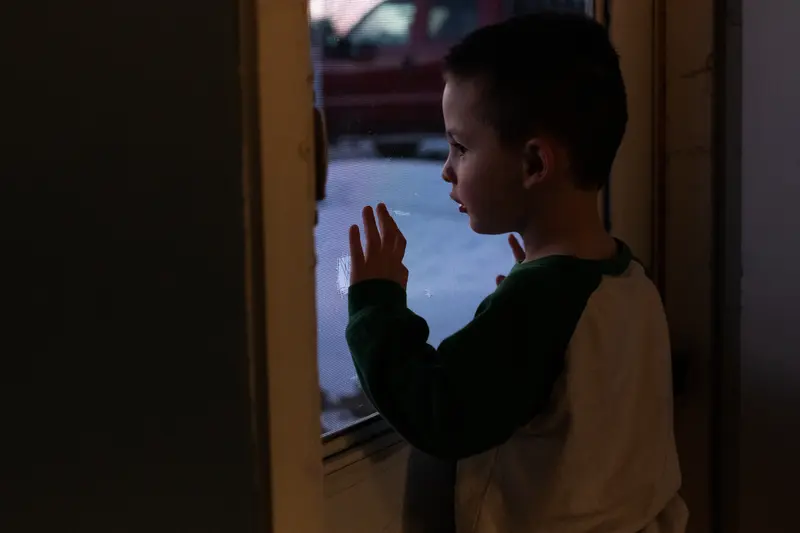ProPublica is a nonprofit newsroom that investigates abuses of power. Sign up for Dispatches, a newsletter that spotlights wrongdoing around the country, to receive our stories in your inbox every week. This story was co-published with The New Yorker.
This story is exempt from our Creative Commons license until Dec. 22, 2023.
Alicia Johansen spent her childhood moving with her drug-addicted mom from one place to the next, trying to brace herself for the moment when the water and the electricity would get cut off. So at 22, when she had a chance to run Dolittle’s pool hall in the ranching town of Akron, Colorado, she was intent on making some money. She kept the bar open deep into the night, after the older guys who bet on horse races departed, and the truckers and the younger crowd, with the meth, drifted in. Meth, she soon discovered, helped her work longer hours.
An occasional customer was Fred Thornton, a former high school baseball star in his early 30s. Fred was sometimes a roofer and at other times unemployed and homeless. They began dating casually and using together, and he told her of his own complicated childhood: placed in foster care as a toddler, after allegations of neglect, and later adopted.
Alicia’s period was irregular because of the meth, which also dimmed her self-awareness. She was six months along before she realized that she was pregnant; a month after that, she woke up in pain. She had preeclampsia, which caused dangerously high blood pressure, and needed an immediate C-section. She was airlifted to a hospital in Denver, a hundred miles away. Her and Fred’s son, Carter James Thornton, was born on Aug. 6, 2019 — two and a half months premature, 2.5 pounds in weight, and, according to his lab work, exposed to meth and to THC.
That first week at the hospital, Alicia hovered over Carter, who was curled beneath a web of tubes and wires, before going home to get baby things. The third week, she and Fred visited their son and held him skin-to-skin. The fourth week, back in Akron, they faltered: They had no gas money for a return to the big city; they were bickering; they were high. On the fifth week, when Carter was stable enough to leave the neonatal intensive care unit, Alicia returned, but foster parents from Akron were the ones who took him home.
Carter’s drug exposure and his parents’ weekslong absence had triggered a call to child protective services and then a neglect case against Alicia and Fred in the juvenile court of Washington County, where they lived. To get their son back, the judge informed them, they’d need to take a series of steps laid out by the county’s human services department: pass random urinalysis drug tests, with missed ones considered positives; secure stable housing and employment; and make it to regular supervised visits with Carter. During the next three months, as the department steadily recorded Alicia and Fred’s positive drug tests and missed visits, none of their excuses were entertained, a hard line for which they would later be grateful. In December, they decided that if they wanted to raise their child together — and they did — they would have to get sober for good.
By the summer of 2020, Alicia and Fred had met every one of the judge’s requirements, and then some. They’d tested negative on more than 30 consecutive drug screens between them, including hair follicle tests that indicated how long they’d been clean. They had continued to visit Carter weekly through the first months of the pandemic, when a “visit” meant trying to entertain an infant over Zoom. Fred took a job as a maintenance man for the county, installing plumbing in low-income housing and mowing the fairgrounds. Alicia left bar work and began delivering mail for the U.S. Postal Service and working the deli counter at a grocery store on her days off. They spent much of what they earned replacing carpets, repainting walls and fogging air ducts to remove any lingering trace of meth from their one-story house, which, before Carter’s arrival, at times lacked water and electricity. They had completed parenting lessons and were in therapy, getting support for their sobriety and learning how to be better partners to each other. In other words, the foster care system, whose goal under federal law is to be temporary, in service of a family reuniting, seemed to be working.
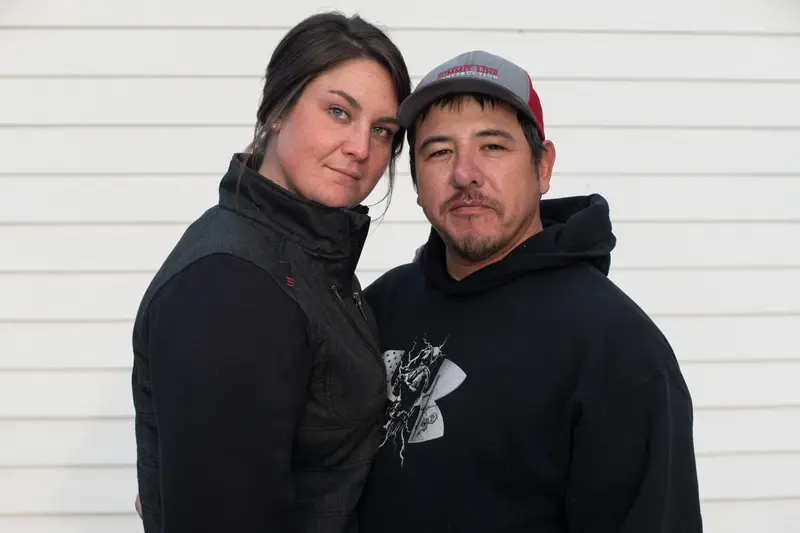 Alicia and Fred
Credit:
Rachel Woolf for ProPublica
Alicia and Fred
Credit:
Rachel Woolf for ProPublica
As the couple hit six months sober, the county’s Department of Human Services added, and the judge approved, one more element to their treatment plan: an expert evaluation of how well they interacted with Carter. If they cleared this last hurdle, Alicia and Fred understood, the system would let them reclaim their son. Alicia worried in advance about whether she could be silly with her baby while under scrutiny and with everything to lose. She would have been more anxious had she known the truth: that she and Fred weren’t just demonstrating their fitness to care for Carter — they were competing for him. His foster parents, hoping to adopt him, had just weeks earlier embraced an increasingly popular legal strategy, known as foster parent intervening, that significantly improved their odds of winning the child.
It has become harder and harder to adopt a child, especially an infant, in the United States. Adoptions from abroad plummeted from 23,000 in 2004 to 1,500 last year, largely owing to stricter policies in Asia and elsewhere, and to a 2008 Hague Convention treaty designed to encourage adoptions within the country of origin and to reduce child trafficking. Domestically, as the stigma of single motherhood continues to wane, fewer young moms are voluntarily giving up their babies, and private adoption has, as a result, turned into an expensive waiting game. Fostering to adopt is now Plan C, but it, too, can be a long process, because the law requires that nearly all birth parents be given a chance before their rights are terminated. Intervening has emerged as a way for aspiring adopters to move things along and have more of a say in whether the birth family should be reunified.
Intervenors can file motions, enter evidence and call and cross-examine witnesses to argue that a child would be better off staying with them permanently, even if the birth parents — or other family members, such as grandparents — have fulfilled all their legal obligations to provide the child with a safe home. When Carter’s foster parents intervened in the hope of keeping him, they turned to the firm of Tim Eirich, a Denver adoption attorney who charges as much as $400 an hour and has almost single-handedly systematized intervention in Colorado.
A video of the two-hour parenting evaluation that would help determine who would raise Carter shows Alicia and Fred sitting on the floor of a utilitarian playroom in a government building, smiling, and their son, now almost 1, grabbing Fred’s baseball cap and chewing on it. Alicia feeds him a bit of red bell pepper, explaining to the evaluator, who sits in a chair just off camera, that an occupational therapist suggested that they introduce Carter to new food textures. Both parents cheer as Carter scootches around, and, intermittently, they answer questions that the evaluator poses in a warm Texas accent. What do they think a successful transition from foster care would look like? How would they characterize Carter’s personality? (“Curious,” “Easy to soothe.”) At one point, Fred confides that the playroom has sparked a memory of his birth mother in a similar space, her black hair down to her waist, shortly before she was erased from his life.
After the visit, the evaluator, a social worker named Diane Baird, made a report to the county. Alicia and Fred were kind to Carter, she noted, and she praised them for remaining sober and being “earnest in their regret” about the mistakes they had made. But she criticized them for repeatedly encouraging Carter to crawl, which he wasn’t quite ready to do, and for giving him the bell pepper — actions, Baird said, that betrayed a lack of understanding that he had developmental delays. “Neither parent has the kind of relationship with Carter that will help him feel safe in a new situation,” she wrote.
When Alicia read the report, she was bewildered. Did Baird not understand how hard it is to bond with a baby you’ve been allowed to see for only a few hours a week, while masked, or in 15-minute stints on Zoom? And why was Carter’s eye contact with her, which Baird had specifically praised during the visit, now described as lacking “affective involvement”? But she and Fred decided to focus on the practical advice that Baird had given them, including not to fall silent around Carter and to face his developmental delays instead of avoiding them.
After a follow-up evaluation a month later, Baird reported that Alicia’s knowledge of child development was deepening and that she and Fred had engaged in imaginative play, as when Fred aced a feeding game by using a toy dinosaur. Nonetheless, Baird opposed Carter’s being returned to Alicia and Fred on the grounds that the foster parent intervenors had reported that he pitched fits and struggled to eat and sleep after seeing them.
Although hired as a consultant by Washington County in this case, Baird had a long-standing independent agenda: helping foster parents across Colorado succeed in intervening and permanently claiming the children they care for. Often working hand in hand with Tim Eirich, she has been called as an expert in, by her count, hundreds of child welfare cases, and she sometimes evaluates visits between birth families and children without having met them. Baird would not say how many foster parent intervenor cases she has participated in, but she can recall only a single instance in which she concluded that the intervenors should not keep the child. Thinking that particular couple would be weak adoptive parents, she told me, she simply filed no report.
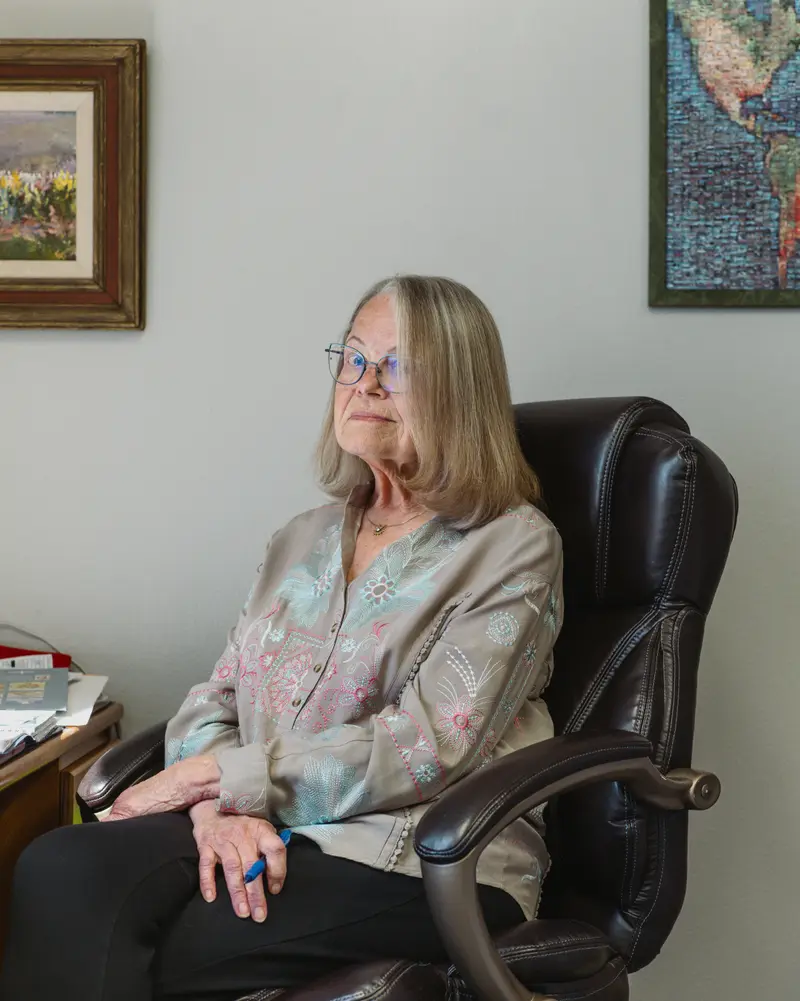 Diane Baird in her office in Wheat Ridge, Colorado
Credit:
Trent Davis Bailey for ProPublica
Diane Baird in her office in Wheat Ridge, Colorado
Credit:
Trent Davis Bailey for ProPublica
In front of the judge in Carter’s case, Baird elaborated on the danger of returning Carter to Alicia and Fred, saying that their visits with him were threatening his primary attachment and causing “a biologic hyperarousal that not only burns calories but self-perpetuates” — a state that becomes worrisome when a child spends “25% to 57% of their time, or whatever,” in it. Rupturing a primary attachment could ultimately cause “sociopathy” in a child, she said.
In February 2021, relying heavily on this expert view, the county moved to permanently terminate Alicia and Fred’s parental rights. All that remained was a hearing in which the judge would make a decision, and, as it approached, the couple felt outmatched. Akron being a small town, they knew something about the people who’d been fostering Carter. Lain Bernhardt, who came from a prominent local ranching family, had once run for mayor. He and his wife, J’Lyn, were teachers, he in the public school system, she at a Head Start program run by a Methodist church.
They lived on a farm, and Alicia could concede that Carter, now a year and a half old, might have a pretty decent life there. But she also knew that, even at the lowest points of her own childhood, she hadn’t wanted to lose her mom forever, as Fred had done. Fred, a Mexican American who had been adopted by a white family, worried that Carter would grow up as tormented about his cultural identity as Fred had been, and as uncertain about whether his birth family fought to keep him. Although he and Alicia sensed that some fix might be in, they promised each other not to give up. Even if they lost, they reasoned, Carter might one day know that he’d been wanted.
In the 1950s, the British psychoanalyst John Bowlby posited that being separated from a maternal figure in the first years of life warps a child’s future ability to form close relationships. He and other psychologists later added nuance to what became known as “attachment theory,” taking into account new research, such as a longitudinal study of children who’d spent their early years in residential facilities, which indicated that some children had more resiliency than Bowlby had initially grasped. In the ensuing decades, the idea that breaking off a primary attachment would do lifelong damage became influential in child-development spheres and eventually infiltrated popular culture. Early in this century, several adoption attorneys “hit on this thing of attachment” and saw its utility, Dale Dove, who co-chairs the Academy of Adoption & Assisted Reproduction Attorneys’ foster care committee, told me. With the supply of adoptable babies dropping, foster children were becoming a “hot commodity,” he said, and he and his colleagues (among them Tim Eirich’s law partner Seth Grob) realized that attachment experts could be called into court to argue that foster children needed to remain with their foster parents in order to avoid a severed bond.
In actuality, young children may endure a range of caregiver transitions, including being removed from birth parents and sent to foster care in the first place, or going through a private adoption or a divorce. When the American Academy of Pediatrics reviewed recent research, it concluded that kids who grow up with their birth family or kin are less likely than those who are adopted or are raised in non-kinship foster care to experience long-term separation trauma, behavioral and mental health problems, and questions of identity. The Trump and Biden administrations have both pressed states to keep a larger percentage of kids with birth parents or kin. Intervention, a state-level counter-trend, is supported by foster parents’ rights groups and advocates at national conservative organizations.
Naomi Schaefer Riley, an American Enterprise Institute senior fellow, has criticized the fact that some states extend the year and a half that federal guidelines give birth parents to rehabilitate themselves. Intervention, she says, helps stop that foster care drift, reduces cavalier reunifications in which children taken away after abuse and neglect are returned to the same circumstances, and clears the path to adoption.
Since 2018, South Carolina’s courts and lawmakers have affirmed the right of any state resident to file to adopt any foster child, as well as the right of foster parents to intervene. In 2020, Kentucky amended its law to let foster parents intervene as legal parties in involuntary terminations of birth parents’ rights. And this year Florida passed a law saying that if birth parents move to have their child adopted, including by a biological family member, long-term foster parents can intervene to contest that outcome. Kathryn Fort, the director of the Indian Law Clinic at Michigan State University, told me that her practice has faced three sets of intervenors this year, all of them non-Native couples seeking to adopt a Native child.
Colorado has been a pioneering state for intervention thanks mostly to Eirich, the lawyer whose firm represented Carter’s foster parents. In 2013, he argued and won a state Supreme Court case that ended almost all limitations on the practice, and in the following five years there was a threefold increase in intervenor cases statewide, according to data from the Colorado Office of Administrative Courts. By 2022, at least 2,500 cases had been filed. A tenth of the state’s child welfare cases now have an intervenor. And with an intervenor, court data indicates, the chance that the birth parents’ rights will be terminated surges from 17% to 43%. Bruce Boyer, Eirich’s former professor at the Loyola University Chicago School of Law, told me that he has become concerned about intervenors “bullying their way” into proceedings in which the termination of parental rights, a grave state power, is on the line.
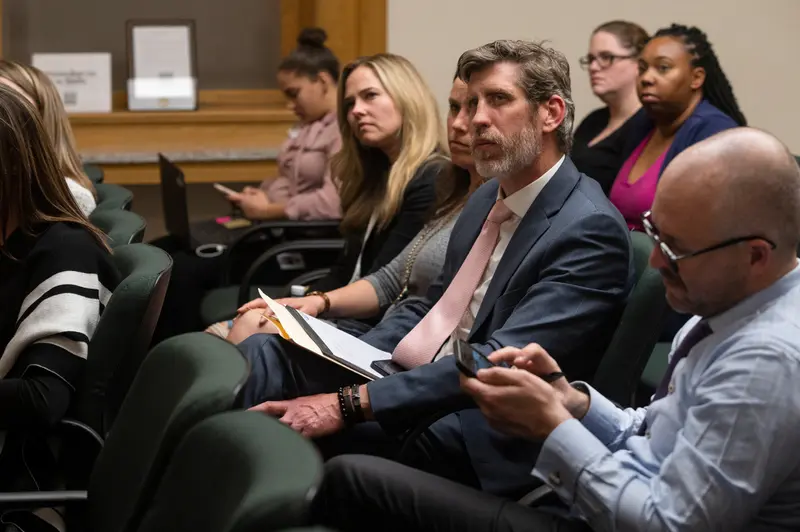 Tim Eirich listens to testimony during a legislative hearing concerning foster care interventions at the Colorado Capitol in Denver in March.
Credit:
Rachel Woolf for ProPublica
Tim Eirich listens to testimony during a legislative hearing concerning foster care interventions at the Colorado Capitol in Denver in March.
Credit:
Rachel Woolf for ProPublica
Eirich’s firm represents nine private adoption agencies across Colorado, and he leads intervenor training sessions for judges and foster parents. He told me that the idea that he helps adopters-to-be thwart the goal of birth-family reunifications is “absolute bullshit.” Most of his clients intervene, he said, primarily in order to help the judge make an informed placement decision: one that considers the child as an individual, instead of prioritizing generalized arguments about biological ties or race. “Colorado empowers people who care about maltreated children to be part of the process,” he says.
He routinely relies on Diane Baird, whom his clients sometimes hire directly, or on an attachment expert whom she has trained. Baird told me that she decided to work so closely with Eirich because “he knew how to use me most effectively.” They both often argue that birth family visits are causing a child damaging emotional swings due to attachment issues. “A healthy attachment trumps biology in the first three years of life, period,” Baird told me. Later, she emailed me something that one of her colleagues likes to say about biological families: “Blood is thicker than water but it’s also a better carrier of disease,” to which Baird added, “LOL.”
It’s not acceptable in most family courts to explicitly argue that, if you have more material advantages to provide a child, you should get to adopt him or her. Outside the courtroom, though, intervenors are sometimes less discreet. During a 2021 case meeting, according to a specialist who took notes, a foster parent and Eirich client said, of the prospect of reuniting a baby boy with his biological family, “He’s used to being raised by a maternal figure who stays home. We have 1.5 acres for him to run around, and they have an apartment.” Another foster parent and Eirich client told me that reuniting a baby girl with her birth mother would mean transitioning her from a “personalized nanny” to a “day care center with, you know, 50 kids running around, and sleeping on a little cot.”
When Carter was ready to leave the hospital in September 2019, J’Lyn and Lain Bernhardt walked into his room in the NICU and found Alicia sitting there, seemingly disengaged from her stunningly small child. Alicia jumped up and thanked them for taking in Carter. As they all watched child safety videos, the Bernhardts did their best to be polite, but they later told me how effortful that had been. “You choose drugs over your child,” Lain said, “and my opinion about you is not going to be positive.”
The Bernhardts care deeply about children. J’Lyn has focused her career on early-childhood education, and Lain, in his mayoral campaign, advocated for after-school programs for older kids. But since they got married as 23-year-olds in 2015, they haven’t had biological children of their own. Realizing that, as they put it, there were plenty of children in this country who needed help, they registered with the county as what is called a foster-to-adopt family, stating their willingness to adopt but agreeing that birth parents must first be given a chance to follow their court-ordered treatment plan. Before Carter, the Bernhardts fostered eight kids, one or two at a time, a draining public service for which they received a monthly payment of around a thousand dollars. In 2018, they adopted one of the children, an 11-year-old boy. But Carter was their first newborn.
He was so underweight that he needed a special high-calorie formula, which he struggled to consume. “It takes over every part of your body that this is an innocent child, and he is here by himself,” J’Lyn told me. Lain said, “People tell you, ‘It’s foster care … it’s temporary.’” But nothing about the situation felt temporary, he said.
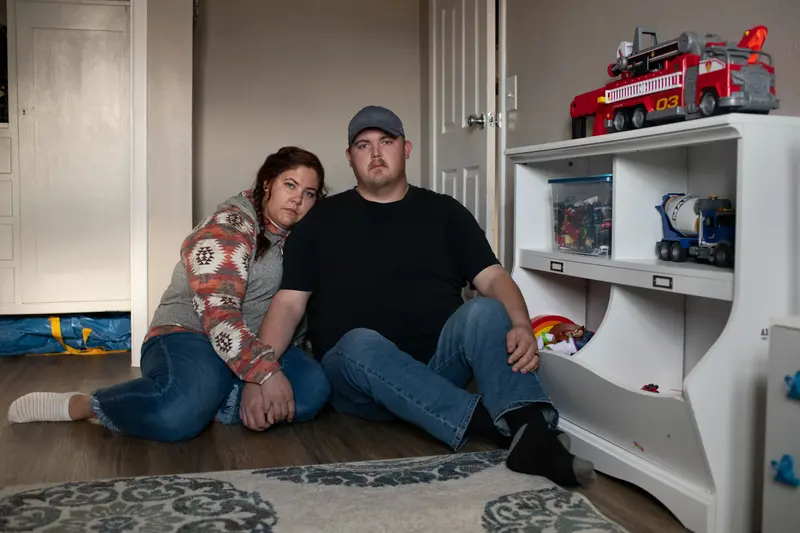 J’Lyn and Lain Bernhardt in Carter’s room in their home in Otis, Colorado, in March.
Credit:
Rachel Woolf for ProPublica
J’Lyn and Lain Bernhardt in Carter’s room in their home in Otis, Colorado, in March.
Credit:
Rachel Woolf for ProPublica
Within days of learning that Carter, at the hospital, needed foster parents, J’Lyn came to work full of emotion, saying that she needed time off because she was getting a baby who’d be fast-tracked for adoption, according to her supervisor at Head Start. (J’Lyn disputes this account.) Before long, she and Lain bonded with Carter; the first time he sat up and the first time he broke into giggles, they cried.
The job of foster parents is inherently difficult on an emotional level. They are told that they’re needed because a child’s parents have severe and potentially dangerous problems, but also that they should support the ultimate goal of returning the child to those same parents. They’re expected to simultaneously love the child and accept that their bond with the child may be broken. And although they may spend all day, every day, with the child, a caseworker usually has more influence than they do in determining what’s in the child’s best interests. Intervening makes some foster parents — whether they went into the process looking to adopt or arrived at that desire over time — feel less helpless.
When the Bernhardts started Googling intervention, they quickly found Eirich’s website and many effusive reviews from foster families who had won contested adoptions with his help. “He’s the one who fought for us to have this right,” Lain told me. But Eirich was too busy to represent them, so they hired his associate Kerry Simpson, with whom Eirich discussed the case as it went along. The Bernhardts, in their motion to intervene, argued that Carter might develop an attachment disorder if separated from them and said that they were concerned about whether his developmental needs would be handled appropriately if there were a change in caregivers. “Cognitive disability and/or autism is likely,” the filing said.
As intervenors, J’Lyn and Lain now had a courtroom standing equal to that of Alicia and Fred, and were allowed to sit in the jury box at hearings.They also began getting visits from Baird, who gave them advice about how to calm Carter when he was stressed. (She would eventually suggest a warm bubble bath, along with setting glow sticks afloat in the tub.) They didn’t need to pay for Baird’s assistance, because, in this instance, she was working for the county. That was lucky; by 2021, payments to Eirich’s firm were consuming their savings.
The problem was that Alicia and Fred would not give up. With the motion to terminate their parental rights hanging over their heads, they hadn’t had a single relapse and were arriving at visits “relentlessly on time,” as one case evaluation put it. Carter was excited by the interesting homemade toys and sensory materials that Alicia brought for him to play with, another report, by a parenting coach, said. (Shaving cream was a particular delight.) The report noted that Carter turned to Fred for reassurance when he struggled, and that Fred could reliably make his son laugh.
Another judge, recognizing Fred’s transformation, had recently granted him full custody of his other son, Robert, who was 12 years old. But by now, Fred and Alicia understood why Carter’s case was different. A social worker had explained that Eirich and Baird “went around the state together” arguing for the termination of birth parents’ rights, Alicia told me. And she guessed that the county backed the Bernhardts too because they’d come forward to foster so many children.
In October 2021, Alicia and Fred felt a little less pessimistic after the county dropped its motion to terminate their rights, admitting in a court filing that it lacked convincing evidence against them. However, Carter remained in foster care, with no transition home planned. This gave his foster parents more time to make their central argument for keeping him: that after visits with Alicia and Fred Carter would still unravel — slapping and kicking, crying and banging his head against the wall, alternating between sleeplessness and nightmares about monsters.
Arguments involving what’s called “post-visit dysregulation” are extremely common in intervenor cases, Allison Green, the legal director of the National Association of Counsel for Children, told me. Although the fits are often interpreted with great authority, she said, “in reality, children may be dysregulated for any number of reasons — perhaps they miss their parent, feel confused, or are simply behaving as toddlers do.” Green used to employ the dysregulation claim in her own cases, she said. She now regrets it.
Hearing of Carter’s distress, Alicia felt “the most unspeakable feeling of defeat,” she told me. “You can’t help your baby, but you’re also being blamed somehow from afar.”
In many intervenor cases, foster parents win after their lawyers undermine the claims of other biological relatives, beyond the parents, who want to keep the child in the family. In 2020, Cynthia Cooley, a home health aide on Long Island, received confirmation after a paternity test that she had a 6-month-old grandson in foster care in Weld County, Colorado. At first, she was unsure if she could be the baby’s caregiver or if another relative should do it. And she was hesitant to elbow in on the rights of her son, the baby’s father, who had recently been released from jail. But before her grandchild turned 1, Cooley, who is Black, decided to uproot her life to take custody of him. She moved to suburban Atlanta to be near extended family and installed a baby gate at the top of the stairs. She completed foster parenting and first-aid classes and took a job operating machinery at a warehouse. Because she knew the long history of Black-family separation in America, from the forced removal of enslaved kin to the ongoing problem of race bias in child welfare, she was jarred when a new word appeared in case documents. “I said, ‘I know what “intervening” means. … The word “intervene” means to interfere,’” she told me.
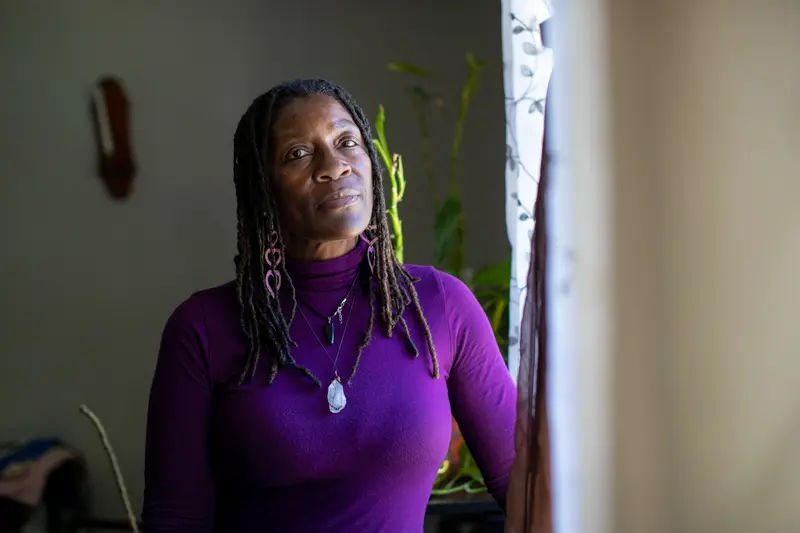 Cynthia Cooley uprooted her life to pursue custody of her grandson.
Credit:
Alyssa Pointer for ProPublica
Cynthia Cooley uprooted her life to pursue custody of her grandson.
Credit:
Alyssa Pointer for ProPublica
Eirich was representing the foster parent intervenors who had custody of Cooley’s grandson. Late last year, in a closing argument, he said that Cooley had taken too long to raise her hand. He also cited a report filed by Baird, who’d never met Cooley, which said that her visits with her grandson, for which she was flying in from Atlanta, were disrupting the boy’s attachment. The intervenors should keep him permanently, Baird concluded.
The Weld County Department of Human Services strongly objected. In a filing, its counsel wrote, “The obligation of the Department is to try and place with family when it is safe, appropriate and available,” and, “Grandmother Cynthia Cooley is absolutely that person.” But, as Eirich underlined to me, though parents have a constitutional right to their child until such right is terminated, grandparents and other relatives have only a preference under state laws. The judge ruled in favor of Eirich’s clients, a social worker and a real estate agent. “Court found [Baird’s] testimony credible. She has significant experience,” the judge said, adding approvingly that Baird’s analysis had “focused on primacy of attachment over cultural considerations.”
Eirich’s clients, who are white, emphasized to me that they’ve fostered multiple children and hadn’t been looking to adopt; they were willing to do so in this case to give the boy a sense of permanency. Because they value biological bonds, they said, they’ve tried to keep Cooley involved. (“The best of both worlds,” Eirich likes to say in court.) They offered Cooley a post-adoption agreement that would legally require them to stay in touch with her. Cooley told me she doesn’t want a contract. She wants her grandson.
Kathy Hammond, a nurse practitioner in rural Farmington, Missouri, was also told that she had waited too long to step up for her grandson. Yet Hammond had repeatedly called the Colorado Department of Human Services to ask about the boy when he was 2 months old in 2017. When he was 3 and 4 months old, she pressed his caseworker in emails, asking for custody. “What is the process at this point?” she wrote. “Will I hear from you or should I expect to hear from someone else? Is there anything else I can/should be doing to be prepared for baby and court? Should I plan a visit to Colorado to meet [the child] or to meet persons involved?” Then she waited on paperwork for a safety inspection of her home, which didn’t happen until well into 2018. The delay was somehow tied to the baby’s Social Security card.
After more confusion, Hammond started driving 14 hours each way for court hearings for her grandchild, who was now a year old. She changed for court in the car, then drove all the way back for work. But, she said, she soon learned something that made her heartsick: “The foster family has the best attorney in Denver” — Eirich.
Eirich argued that the boy’s developmental and medical issues — including tremors and other abnormal movements — prevented a transition of caregivers, even to a veteran nurse practitioner. Yet his client, a foster mother named Jody Britton, had already had the tremors checked out by multiple doctors. After an EEG, a neurologist at the University of Colorado Anschutz Medical Campus reported, “Foster mom still feels that there is something wrong with him but his exam is normal today.”
Britton, an evangelical Christian who lives in the Denver suburbs with her husband, a pastor, and has adopted children from Africa, ultimately won permanent custody. She is now a leading advocate for the rights of intervenors like her in Colorado, through a group called Foster Source. As she points out, under a state statute, she was designated as a kinship foster placement because she was close with the birth mother’s sister. She says that the blame lies with the county for failing to inform her for a year that Hammond was seeking custody. By then, she said, she understood the boy’s medical needs better than another caretaker would. “We intervene so we can sleep at night,” she told me. “We need to know we are doing everything we can.”
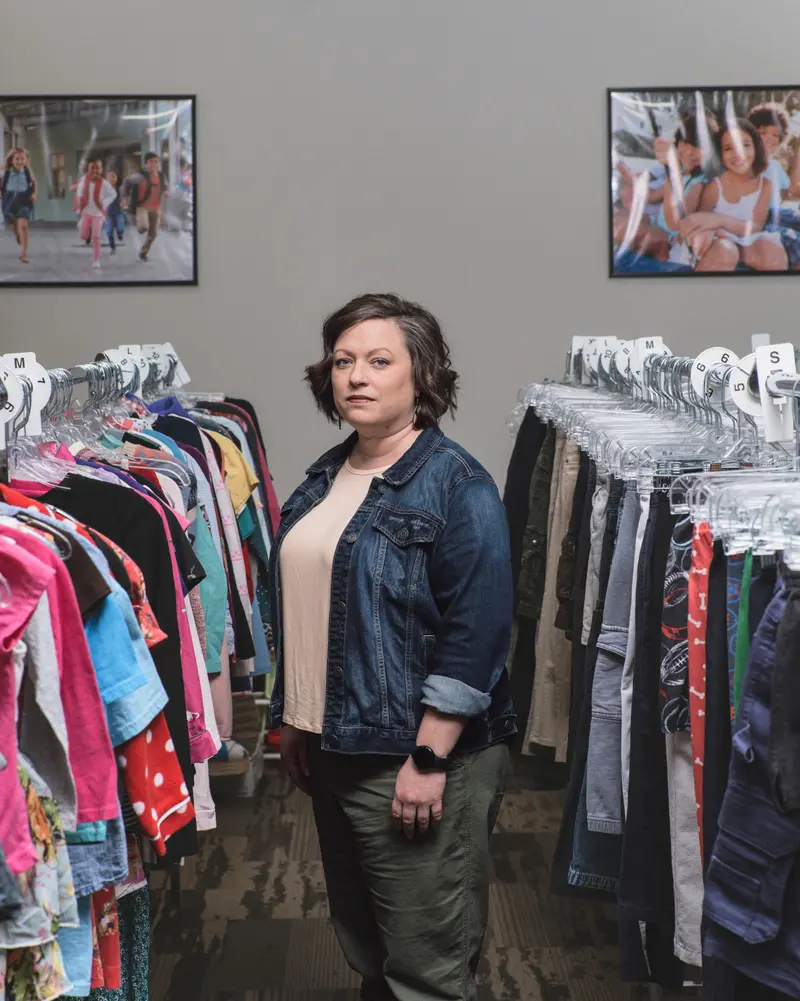 Jody Britton at the headquarters of Foster Source in Westminster, Colorado
Credit:
Trent Davis Bailey for ProPublica
Jody Britton at the headquarters of Foster Source in Westminster, Colorado
Credit:
Trent Davis Bailey for ProPublica
Children with developmental disorders are, unsurprisingly, overrepresented in foster care. Some were exposed to drugs or alcohol in utero, some were neglected after coming into the world. Separation from a birth parent can itself be traumatic, and so can being placed with one foster family after another, as many children are. Sincere concern often drives foster parents to have kids in their care tested for social, emotional and learning delays and to enroll them in speech, physical and other therapies.
But Paul Spragg, a Colorado forensic psychologist with 30 years’ experience with child welfare cases, told me that even if there is no formal diagnosis, “intervenors with a view toward adopting a kid have an interest in reporting issues that ultimately make adoption by them more likely.” In court, a barrage of tests and therapies often serves the twinned arguments that it’s too sensitive a moment to transition the child back to the birth family and that the birth family may be ill prepared to care for the child.
The Bernhardts reported that Carter ate things that he wasn’t supposed to, like fuzz from his diaper. In response to this and other developmental concerns raised by the Bernhardts, Carter’s caseworker and experts who had been hired to examine him, the county had him tested in 2021 for autism spectrum disorder, which the Bernhardts had suggested he had when they first intervened. A clinical psychologist found that he had normal social functioning for his age but that the fuzz-eating could be attributed to pica, a condition marked by eating nonfood items, and that other signs of distress might be caused by “upbringing away from parents.” Officials also had Carter’s brain “mapped” by a local therapist using the “neurosequential model of therapeutics” originally developed by the psychiatrist Bruce Perry; the results proved too murky to be used by either side. Janina Fariñas, another clinical psychologist who evaluated him for the county, told me, “There was almost a need for Carter to not be OK.”
In July 2022, I watched a hearing in Carter’s case held by videoconference. Alicia and Fred, sitting cross-legged on their living room floor, were frustrated that they couldn’t hear, let alone counter, much of what the county’s lawyer was saying about them. The judge, for his part, lamented all the medical tests. “We’re going to turn this kid into a lab rat,” he said. He then told the Bernhardts’ lawyer, the Eirich associate, “Sometimes I think your clients are being a little bit coy. They need to flat out say what they want. Are they foster parents who just want what’s best for this child, or do they want to adopt?”
Despite his palpable skepticism, the judge did little but say that he would await responses to a motion and schedule another hearing. Days later, the county again filed for the termination of Alicia and Fred’s parental rights. Although the couple had complied with their treatment plans, the filing concluded, their son had been in foster care for three years and needed “the permanence that only adoption can afford him.” Intervening is usually “buttoned up relatively quickly,” Lain told me, especially in cases involving very young children. So he and J’Lyn were pleased by the new termination filing, and to learn that the county had again brought in an expert — Diane Baird — to assess Alicia and Fred’s parenting of Carter. Before long, following sessions that Alicia and Fred thought had gone well, Baird was reporting that Carter’s eyes were “dark and bottomless” and that he had a “tic-like blink.”
Whenever Carter ran up to Fred to start a game of tag, saying, “Try and get me,” Fred froze, worried that if he gave chase a reference to Carter fleeing him in fear might end up in a report. “If Carter laughed, it was the wrong type of laugh,” he told me. “If Carter was running, he’d be ‘hyperaroused.’” Fred had by now come to think of Baird as some wicked Jedi, converting his positive interactions with Carter into dark ones. Alicia shushed him when he talked like that in public. “If you do everything right and you tell the truth,” she told him, “at some point, you’re gonna come out on top.” He thought she was being naive.
Baird has long called her technique for evaluating parent-child interactions the “Kempe protocol for interactional evaluation,” after the prestigious Kempe Center, the child welfare branch of the University of Colorado medical school where she worked, on and off, from the mid-’80s until 2017. Early on, she helped a colleague develop the method, which extrapolated sweeping conclusions about how parents and children relate from subtle observations of eye contact and body language. Last year, the Kempe Center’s director asked Baird in an email to stop using the Kempe name to describe her protocol and to make clear on her CV that she no longer works there.
Patrice Harris, a child and adolescent psychiatrist and a past president of the American Medical Association, says that although children placed in a series of foster homes may have lifelong trust issues, a child who has had one good experience with a foster family often benefits from it. “That secure placement can enhance their ability to attach again,” she told me. The child’s brain has been wired that adults can be trusted.
Carter started preschool in the autumn of 2022, with the trial to decide his fate set for just before Christmas. As the date approached, Alicia and Fred, frantic, latched onto an idea that someone they’d met through parenting class had suggested: What if they could get taxpayers to care about all the money the government had spent to keep them from their child?
They filed a Colorado Open Records Act request and soon received dozens of invoices. In all, tiny, unaffluent Washington County had spent more than $310,000 on Carter’s case: on his brain mapping and medical exams, on the many expert evaluations, on Baird’s travel to and from Denver, on payments to the Bernhardts, and so on. In December, the director of the Department of Human Services, Grant Smith, resigned. Two days later, a letter from an attorney representing Washington County revealed that an internal investigation had found improprieties in the handling of Carter’s case. (The investigative report is under a gag order, and neither Smith nor the new director would elaborate on the resignation.) The trial was canceled, and in February, the judge asked for an explanation of what, exactly, was still unfit about Alicia and Fred as parents. The following day, the county finally dropped its case.
“It’s over,” Alicia’s lawyer told her when she answered the phone. Alicia gestured wildly at Fred to turn down the TV. The lawyer went on, “After his next visit … you don’t have to give him back.”
 A calendar marking Carter’s arrival date at Alicia and Fred’s home
Credit:
Rachel Woolf for ProPublica
A calendar marking Carter’s arrival date at Alicia and Fred’s home
Credit:
Rachel Woolf for ProPublica
In March, Alicia’s fellow mail carriers threw a party at the Akron senior center with cake and presents. It was a baby shower for a 3.5-year-old boy. The following month, Alicia joined other birth families in testifying in favor of new state legislation that would give biological relatives more priority in foster care cases and prevent foster parents from intervening until they had cared for a child for a year. In August, that law went into effect.
As Colorado grapples with how prevalent foster parent intervention has become, other states are taking the intervenor concept further. At least 15 states, from New York to Tennessee to Arizona, now allow foster parents to directly file to terminate a biological parent’s rights, as if they were prosecutors.
In Indiana, the adoption attorney Grant Kirsh handles, by his count, around 500 adoptions of foster children every year, and he educates foster parents about the process on his YouTube channel. Kirsh tells them that, should the state’s child services agency move to return a child in their care to the child’s birth family, they can simply serve a notice of adoption, which the birth family will have only 15 days to contest. If there is no response in that time frame, the birth family loses the right to challenge the adoption.
“It’s nuts,” Andrea Marsh, a family court lawyer in Indianapolis, said, calling the process “similar to intervention, but the nuclear option.” One of her recent clients, a birth mother in Indianapolis, was trying to follow her court-ordered treatment plan when the suburban foster parents who were caring for her child filed for adoption in their home county. (Court-shopping is a strategy that Indiana adoption attorneys use to circumvent a court that is still trying to reunify the birth family.) The mother failed to reply by the deadline and, when the adoption of her child was finalized, neither she nor the local child services office could do anything about it.
First image: Fred unloads Carter’s backpack after school. Second image: Alicia and Carter run outside near their home.
Credit:
Rachel Woolf for ProPublica
First image: Alicia and Carter stretch after his nap. Second image: Carter looks out the window of their home.
Credit:
Rachel Woolf for ProPublica
In his first weeks living with Alicia and Fred, Carter would ask where J’Lyn was and for certain toys he used to have, like “the ones with the buttons.” When he grew quiet and seemed sad, Alicia found that what often helped was a visit to a playground, the one with the red slides. By late spring, he had stopped getting quiet. “Can we tell Dad I slept so good?” he asked his mom with excitement one morning, and Alicia wondered if he knew or sensed that his sleep problems had been debated for years.
According to an assessment administered at Carter’s preschool, he is on target developmentally and even “potentially gifted.” When I mentioned to Baird that there is little sign of the attachment trauma she predicted, she said this just demonstrates that Carter knows he has to “hero on.”
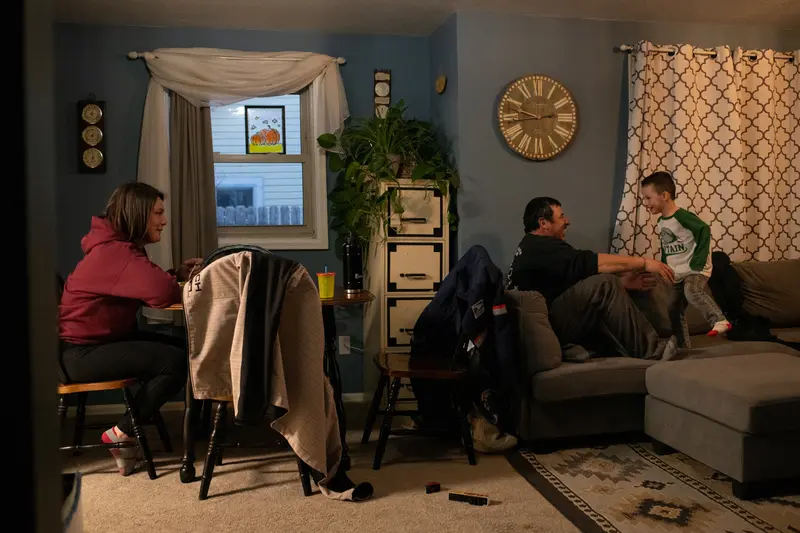 Carter and Fred play while Alicia looks on.
Credit:
Rachel Woolf for ProPublica
Carter and Fred play while Alicia looks on.
Credit:
Rachel Woolf for ProPublica
Alicia and Fred kept Carter enrolled at the Head Start program where both Bernhardts now worked and where Carter could run up and give them hugs. After school one day, Alicia said to herself, “Screw it, I’ll go talk to her.” She walked into J’Lyn’s classroom and said that she hoped J’Lyn would remain in Carter’s life so that, as Alicia put it to me, “these two halves of his life are no longer halves.” Both women later told me that they had bonded over the fact that neither much liked the other’s man.
Shortly afterward, however, the Bernhardts moved to Texas — in part to avoid seeing Carter every day. One afternoon, looking out at the large backyard of their new home just outside Abilene, the couple told me that they’d paid around $32,000 to Eirich’s firm. “We didn’t do any of this for any reason other than to make sure that Carter has the best life,” J’Lyn told me later. “He deserves that.”
Just before visiting the Bernhardts, I’d been with Alicia and Fred in a home, once a meth den, that was brimming with kids’ books, drawings and water guns. Child-size cowboy boots sat by the front door, and Carter was out playing with cousins he once didn’t know he had. At the kitchen table, Alicia told me that the Bernhardts “can be victims, too.” Once the system “put this idea in their heads that adoption could be an achievable goal for them, it damaged our family, and my son, and the foster parents’ family.” She paused, thinking over all that J’Lyn and Lain had gone through. “God, how heartbreaking would that be.”
ProPublica is a nonprofit newsroom that investigates abuses of power. Sign up for Dispatches, a newsletter that spotlights wrongdoing around the country, to receive our stories in your inbox every week. This story was co-published with The New Yorker.
This story is exempt from our Creative Commons license until Dec. 22, 2023.
ProPublica is a nonprofit newsroom that investigates abuses of power. Sign up for Dispatches, a newsletter that spotlights wrongdoing around the country, to receive our stories in your inbox every week. This story was co-published with The New Yorker.
This story is exempt from our Creative Commons license until Dec. 22, 2023.










